#Maria of Anjou
Photo

Mary, also known as Maria of Anjou (1371 – 17 May 1395), reigned as Queen of Hungary and Croatia (formally "king") between 1382 and 1385, and from 1386 until her death. She was the daughter of Louis the Great, King of Hungary and Poland, and his wife, Elizabeth of Bosnia. Mary's marriage to Sigismund of Luxembourg, a member of the imperial Luxembourg dynasty, was already decided before her first birthday. A delegation of Polish prelates and lords confirmed her right to succeed her father in Poland in 1379.
Having no male siblings, Mary was crowned "king" of Hungary on 17 September 1382, seven days after Louis the Great's death. Her mother, who assumed regency, absolved the Polish noblemen from their oath of loyalty to Mary in favor of Mary's younger sister, Jadwiga, in early 1383. The idea of a female monarch remained unpopular among the Hungarian noblemen, the majority of whom regarded Mary's distant cousin, Charles III of Naples, as the lawful king. To strengthen Mary's position, the queen mother wanted her to marry Louis, the younger brother of Charles VI of France. Their engagement was announced in May 1385.
Charles III of Naples landed in Dalmatia in September 1385. Sigismund of Luxembourg invaded Upper Hungary (now Slovakia), forcing the queen mother to give Mary in marriage to him in October. However, they could not prevent Charles from entering Buda. After Mary renounced the throne, Charles was crowned king on 31 December 1385, but he was murdered at the instigation of Mary's mother in February 1386. Mary was restored, but the slaughtered king's supporters captured her and her mother on 25 July. Queen Elizabeth was murdered in January 1387, but Mary was released on 4 June 1387. Mary officially remained the co-ruler with Sigismund, who had meanwhile been crowned king, but her influence on the government was minimal. She and her premature son died after falling from her horse during a hunting trip.
70 notes
·
View notes
Text
On This Day In History
September 17th, 1382: Maria (Mary) of Anjou is crowned king of Hungary. her younger sister, Jadwiga (Hedwig) of Anjou would be crowned king of Poland two years later.
60 notes
·
View notes
Text




My favourite The Crown Of The Kings outfits 3/?
Mary's of Anjou white gown with the beige coat
50 notes
·
View notes
Text

A mythological portrait of King Louis XIV and the French royal family by French painter Jean Nocret.
#king louis xiv#philippe duke of orleans#henriette anne stuart#anne marie louise of orleans#queen henrietta maria#anne of austria#maria theresa of spain#louis grand dauphin#marie therese madame royale#philippe charles duke of anjou#marguerite louise of orleans#elisabeth marguerite of orleans#francoise madeleine of orleans#royal painting#art
15 notes
·
View notes
Text

You are welcome for the lists! This one is fics recs for "Orison". They are all related to that episode, though they're not all angsty smut fics. So it's not quite the ask, but I hope you and others enjoy the stories!
Another Dark Forest by @aloysiavirgata
Post-Orison sex
Anyone with a Gun by V. Salmone (Punk and Sab)
Mulder, Scully, and a gun.
Atomic Split by Pteropod
The world is glued together by the strong force, the weak force, the electromagnetic force, and gravity.
Better Angels by wonderland (@amplifyme)
“She’s okay, Maggie, I promise... No, no, just forget whatever you might hear. Don’t even watch the local news. She’s okay. She’s safe and resting. I got it.” Jesus, how many times had he had this conversation with her, or one very much like it? More than he’d ever wanted to.
Black Hole Season by Penumbra (@mashnotesofthemythopoeic)
Mulder muddles through the aftermath of Orison.
Ceremony by @darwin-xf
What’s left when words fail?
Cold Comfort by Joann Humby
When 3 men die, the killer seems to have a story to tell, but is it the same one that people are hearing? X-Files are dangerous, very dangerous if you're working alone.
Exorcist Stairs by Elanor G
Scully is adrift and on her own after the events of Orison. A chance encounter forces her to confront the banality of evil...
fluorescence and night on all sides by audries (@audriesfic)
He steps over a corpse to touch her.
Ghast by @leiascully
(No summary provided)
Glub-Glub-Glub and Calming Spells by PostApocolypticAlien (@scullysexual)
“you can stay here, tonight. for as long as you’d like.” / “Hey babe, babe, wake up.”
The Devil's Instant by Maria Nicole
Post-ep for Orison
Incorruptible by Anjou
A submission for an epistolary challenge on the Scullyfic/E-muse list in January of 2000. Set mid-season 7, immediately after the events of Orison, when Scully has been faced with an evil from her past. Mytharc heavy.
i have your dreams and your teeth marks by audries (@audriesfic)
Also in the trunk of the car: the latest edition of JAMA, The Amityville Horror on VHS from Blockbuster, Moby Dick, a Jewel CD, a bag of clementines. Her still-closed Bible. - post-orison. mulder takes scully on a witch hunt. there's nail polish involved.
Imperfect Shadow by Nicknoc
In a dark time, the eye begins to see, I meet my shadow in the deepening shade.
Intuituve Reasoning, I Say Obsessive, You Say Compulsive, and I Can Eat Glass by Mish
You can’t fool *all* of the people, *all* of the time. / Kosseff vs. Mulder - one analysis, seven minute time limit. / A late night distress call shatters the calm.
The Nearness of You by a_steady_wish
Her first night back in her own bed after the events of Orison, and Mulder is there to comfort and love her.
Neptune's Ocean by M. Sebasky
(No summary provided)
Nothing Apart by Dyann Zimmerman
What happened after the events in 'Orison'.
Noyade by Rocketman
Noyade--(french) whirlpool.
Of Ladies Most Deject And Wretched by Circe Invidiosa and Helen Quilley (@invidiosa)
It wasn't a question worth answering...post Orison.
Orison by @scullywolf
The aftermath of Pfaster's attack takes its toll in more ways than one.
Possession by @mldrgrl
Based on this prompt request: Mulder and Scully have both dealt with abductions and kidnappings where they were held against their will. I imagine that it took a while for them to feel comfortable with any type of bondage. I think it’d be interesting to explore how or when they became comfortable with that and if it felt really empowering the first time. I especially see Scully having reservations at first but maybe requesting it.
the praxis of a water bed by skuls (@ghostbustermelanieking)
Five of the first times Scully woke up in Mulder's bed.
Right Here by @smalldisbeliever
The soft thud of her duffle bag hitting the floor marks their arrival at her apartment. It’s been a little over a week since Donnie Pfaster tore through the space.
Sedimentation by Maria Nicole
Musings on the edge of sleep
Sins Remembered by rah
What happens after they leave her apartment.
soap bubble memories by @softnow
five times mulder and scully showered together + one time they bathed.
Some Nights by otto_tis_eratai
Or "Six times Mulder and Scully slept together, and one time they did something more". A collection of seven one shots, all post/mid episode (although it can be also read as one story). Some fluff, some angst, some hurt/comfort elements, eventual smut, a lot of friendship.
Submerged by hellsteeth (@wexleresque)
Mulder helps Scully cope with her post-Orison anxiety
Taller Than Other Waves by amyhit (mayhit)
She read Salem’s Lot at ten years old, was brave enough to kiss her partner by thirty-five.
That Was Then, This Is Now by @mldrgrl
The difference between how Scully deals with the aftermath of Donnie Pfaster in Orison v. Irresistible.
Unintended Consequences by Sarah Segretti
Just when you think you know how you’d react to a horrific event, life steps up to surprise you. Scully and Mulder deal with the aftermath of the Pfaster shooting.
Untitled by @aloysiavirgata
Prompt: alternate post-Orison where Scully doesn’t get to her gun and Mulder is the one that kills Pfaster.
Untitled by @aloysiavirgata
Prompt: Scully to Mulder: Make me feel alive again...
Untitled by @o6666666
Prompt: can't wait to read their argument for anniversary date. who would win???
Walls by Ellie
I can't hold out forever; even walls fall down. An Orison post-ep.
The Weight of Water by @dashakay
The aftereffects of trauma are sometimes unexpected.
98 notes
·
View notes
Text
Ages of English Queens at First Marriage
I have only included women whose birth dates and dates of marriage are known within at least 1-2 years, therefore, this is not a comprehensive list. For this reason, women such as Philippa of Hainault and Anne Boleyn have been omitted.
This list is composed of Queens of England when it was a sovereign state, prior to the Acts of Union in 1707. Using the youngest possible age for each woman, the average age at first marriage was 17.
Eadgifu (Edgiva/Ediva) of Kent, third and final wife of Edward the Elder: age 17 when she married in 919 CE
Ælfthryth (Alfrida/Elfrida), second wife of Edgar the Peaceful: age 19/20 when she married in 964/965 CE
Emma of Normandy, second wife of Æthelred the Unready: age 18 when she married in 1002 CE
Ælfgifu of Northampton, first wife of Cnut the Great: age 23/24 when she married in 1013/1014 CE
Edith of Wessex, wife of Edward the Confessor: age 20 when she married in 1045 CE
Matilda of Flanders, wife of William the Conqueror: age 20/21 when she married in 1031/1032 CE
Matilda of Scotland, first wife of Henry I: age 20 when she married in 1100 CE
Adeliza of Louvain, second wife of Henry I: age 18 when she married in 1121 CE
Matilda of Boulogne, wife of Stephen: age 20 when she married in 1125 CE
Empress Matilda, wife of Henry V, HRE, and later Geoffrey V of Anjou: age 12 when she married Henry in 1114 CE
Eleanor of Aquitaine, first wife of Louis VII of France and later Henry II of England: age 15 when she married Louis in 1137 CE
Isabella of Gloucester, first wife of John Lackland: age 15/16 when she married John in 1189 CE
Isabella of Angoulême, second wife of John Lackland: between the ages of 12-14 when she married John in 1200 CE
Eleanor of Provence, wife of Henry III: age 13 when she married Henry in 1236 CE
Eleanor of Castile, first wife of Edward I: age 13 when she married Edward in 1254 CE
Margaret of France, second wife of Edward I: age 20 when she married Edward in 1299 CE
Isabella of France, wife of Edward II: age 13 when she married Edward in 1308 CE
Anne of Bohemia, first wife of Richard II: age 16 when she married Richard in 1382 CE
Isabella of Valois, second wife of Richard II: age 6 when she married Richard in 1396 CE
Joanna of Navarre, wife of John IV of Brittany, second wife of Henry IV: age 18 when she married John in 1386 CE
Catherine of Valois, wife of Henry V: age 19 when she married Henry in 1420 CE
Margaret of Anjou, wife of Henry VI: age 15 when she married Henry in 1445 CE
Elizabeth Woodville, wife of Sir John Grey and later Edward IV: age 15 when she married John in 1452 CE
Anne Neville, wife of Edward of Lancaster and later Richard III: age 14 when she married Edward in 1470 CE
Elizabeth of York, wife of Henry VII: age 20 when she married Henry in 1486 CE
Catherine of Aragon, wife of Arthur Tudor and later Henry VIII: age 15 when she married Arthur in 1501 CE
Jane Seymour, third wife of Henry VIII: age 24 when she married Henry in 1536 CE
Anne of Cleves, fourth wife of Henry VIII: age 25 when she married Henry in 1540 CE
Catherine Howard, fifth wife of Henry VIII: age 17 when she married Henry in 1540 CE
Jane Grey, wife of Guildford Dudley: age 16/17 when she married Guildford in 1553 CE
Mary I, wife of Philip II of Spain: age 38 when she married Philip in 1554 CE
Anne of Denmark, wife of James VI & I: age 15 when she married James in 1589 CE
Henrietta Maria of France, wife of Charles I: age 16 when she married Charles in 1625 CE
Catherine of Braganza, wife of Charles II: age 24 when she married Charles in 1662 CE
Anne Hyde, first wife of James II & VII: age 23 when she married James in 1660 CE
Mary of Modena, second wife of James II & VII: age 15 when she married James in 1673 CE
Mary II of England, wife of William III: age 15 when she married William in 1677 CE
105 notes
·
View notes
Text





Acri, Calabria, Italy
Acri in Calabria is sometimes described as the "door to the Sila mountains", yet the town appears impenetrable which could be due to a long history of violence.
In the Middle Ages, during the reign of the Norman King Federico II, Acri enjoyed a period of relative peace and economic prosperity, and it became an important centre for the silk trade.
In the 15th century, the power struggle between the French House of Anjou and the Spanish Crown of Aragon nearly destroyed the town. In 1462, a local duke obtained permission from the Aragonese King Ferdinand I of Naples to collect taxes in Acri. When people protested and proclaimed loyalty to the former Angevin rulers, they were seized by troops from the Aragonese army.

Even at that time, Acri must have seemed impenetrable to outsiders, for the Spanish soldiers failed to take the city, until they found a traitor who revealed the secret signals that opened the city gates. The soldiers attacked Acri with incredible cruelty, and it is estimated that 2000 citizens lost their lives. Women and children who had taken refuge in the church of Santa Maria Maggiore were burned to death, and the leader of the guards was publicly sawed in four pieces while still alive, and the limbs were exposed from the four towers of the castle.
Such history of violence is in stark contrast to the quiet peace you can experience today in Acri. But the ruins of the old castle with its one remaining tower still hover over the city as a reminder of times gone by.

Photos by Italian Notes
Follow us on Instagram, @calabria_mediterranea
#acri#calabria#italy#italia#south italy#southern italy#mediterranean#italian#city#town#cityscape#history
45 notes
·
View notes
Text
THIS DAY IN GAY HISTO
based on: The White Crane Institute's 'Gay Wisdom', Gay Birthdays, Gay For Today, Famous GLBT, glbt-Gay Encylopedia, Today in Gay History, Wikipedia, and more … March 25


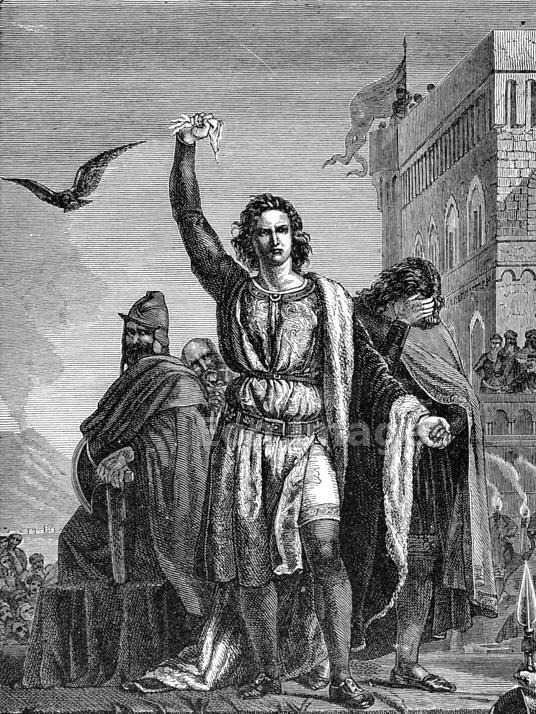
1252 – Conrad, Bavarian royalty, born (d.1268); called the Younger or the Boy, but usually known by the diminutive Conradin, was the Duke of Swabia (1254-1268, as Conrad IV), King of Jerusalem (1254-1268, as Conrad III), and King of Sicily (1254-1258 as Conrad II). He was born in Wolfstein, Bavaria, son of Conrand IV of Germany. He is sometimes known as Conrad V, though he never succeeded his father in Germany.
Conradin was the last legitimate Hohenstaufen, tafter the assassination of Conrad IV. We know little of his appearance and character except that he was "as beautiful as Absalom and spoke good Latin".
While he was still a child in Germany, his uncle Manfred made himself king of Sicily (1258), but when Manfred died eight years later, the kingdom was seized by Charles of Anjou. Conradin was persuaded to come to Italy to recover his kingdom, and, accompanied by his lover, Frederick of Baden, titular Duke of Austria, he gained the support of several Italian cities.
In the end, however, Conradin was captured by Charles, tried as a traitor and beheaded. His lover, Frederick, at his own request, was executed with him. Conradin was just 16; Frederick was 21. To this day Gay lovers make pilgrimages to the church of the monastery of Santa Maria del Carmine at Naples, where the two young men were laid to rest, together.


1479 – Grand Prince Vasily III of Moscow, (d.1533), Prince and military general. Vasily was homosexual throughout his life. He went to the extent of announcing this fact to other gay men of his time by shaving off his beard when his twenty-year marriage to his first wife was terminated - being beardless was a sort of gay password at the time.
During Vasily's second marriage, he was able to perform his conjugal duties only when an officer of his guard joined him and his wife in bed in the nude.

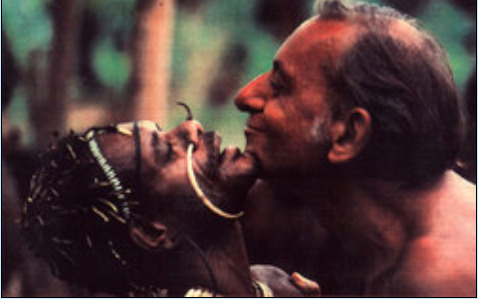
1922 – Tobias Schneebaum (d.2005) was an American artist, anthropologist, and AIDS activist. He is best known for his experiences living, and traveling among the Harakmbut people of Peru, and the Asmat people of Papua, Western New Guinea, Indonesia then known as Irian Jaya.
He was born on Manhattan's Lower East Side and grew up in Brooklyn. In 1939 he graduated from the Stuyvesant High School, moving on to the City College of New York, graduating in 1943 after having majored in mathematics and art. During World War II he served as a radar repairman in the U.S. Army.
In 1947, after briefly studying painting with Rufino Tamayo at the Brooklyn Museum of Art, Schneebaum went to live and paint in Mexico for three years, living among the Lacandon tribe. In 1955 he won a Fulbright fellowship to travel and paint in Peru. After hitch-hiking from New York to Peru, he lived with the Harakmbut people for seven months, where he slept with his male subjects and claimed to have joined the tribe in cannibalism on one occasion.
The Harakmbut treated him well. They taught him words from their language and otherwise communicated through gesture. They shared their food with him and decorated his body in red pigments. At night in their communal hut, the Arakmbut men welcomed him into a warm body pile. These entanglements often turned sexual, to Schneebaum's delight. As he would later write, he had at last found a place where people "would accept me, teach me how to live without a feeling of aloneness, teach me love and allow for my sexuality."
Until 1970 he was the designer at Tiber Press, then in 1973 he embarked on his third overseas trip, to Irian Jaya in South East Asia, living with the Asmat people on the south-western coast. He helped establish the Asmat Museum of Culture and Progress. Schneebaum would return there in 1995 to revisit a former lover, named Aipit. He recounted his journey into the jungles of Peru in the 1961 memoir Keep the River on Your Right. In 1999, he revisited both Irian Jaya and Peru for a documentary film, also titled Keep the River on Your Right.
Schneebaum spent the final years of his life in Westbeth Artists Community, an artists' commune in Greenwich Village, and died in 2005 in Great Neck, New York. He bequeathed his renowned Asmat shield collection to the Metropolitan Museum of Art in New York City and his personal papers are preserved within the Jean-Nickolaus Tretter Collection in Gay, Lesbian, Bisexual and Transgender Studies.


1942 – Richard O'Brien (born Richard Timothy Smith in Cheltenham, England) is a writer, actor, television presenter and theatre performer. He is perhaps best know known for writing the cult musical The Rocky Horror Show and for his role in presenting the popular TV show The Crystal Maze.
In addition to writing The Rocky Horror Show O'Brien also starred in its 1975 film adaptation The Rocky Horror Picture Show as the character Riff Raff. The stage show has been in almost continuous production since, and the cinematic version is one of the best known and most ardently followed cult films of all time.
In 1952, he emigrated with his family to Tauranga, New Zealand where his father had purchased a sheep farm. After learning how to ride horses, a skill which provided him with his break into the film industry as a stuntman in Carry On Cowboy, and developing a keen interest in comic books and horror films, he returned to England in 1964. Upon launching his acting career he changed his name to O'Brien — his mother's maiden name — as there was already an actor named Richard Smith.
He joined several stage productions as an actor without ever excelling or receiving critical acclaim, but that was not his primary objective. In 1972, he met director Jim Sharman who would help make his draft of a gothic-themed, schlock-horror comic-book fantasy romp into a reality. The script took O'Brien 6 months to write, Sharman suggested changing the working title They Came from Denton High to The Rocky Horror Show and the show opened in June 1973.
He became a serial bit-part actor in cult films and has appeared in notable movies such as Flash Gordon (1980), Dark City (1998) and Dungeons & Dragons (2000).
O'Brien has married twice and fathered three children. In a 2009 interview he spoke about an ongoing struggle to reconcile cultural gender roles and described himself as being transgender or possible third sex. O'Brien stated, 'There is a continuum between male and female. Some are hard-wired one way or another, I'm in between.' He expounded on this in a 2013 interview where he talked about using oestrogen for the previous decade, and that he views himself as 70% male and 30% female.


Elton John and David Furnish.
1947 – Elton John, English singer and songwriter, born; (born Reginald Kenneth Dwight) is an English pop/rock singer, composer, and pianist.
In his four decade career, John has been one of the dominant forces in rock and popular music, especially during the 1970s. He has sold more than 250 million albums, and over one hundred million singles, making him one of the most successful artists of all time. He has more than 50 Top 40 hits including seven consecutive #1 U.S. albums, 59 Top 40 singles, 16 Top 10, 4 #2 hits, and nine #1 hits. He has won five Grammy awards and one Academy Award. His success has had a profound impact on popular music and has contributed to the continued popularity of the piano in rock and roll. In 2004, Rolling Stone ranked him #49 on their list of the 100 Greatest Artists Of All Time.
In the late 1960s, John was engaged to be married to his first lover, secretary Linda Woodrow, who is mentioned in the song "Someone Saved My Life Tonight". He married German recording engineer Renate Blauel in 1984, in Darling Point, Sydney, with speculation that the marriage was a cover for his homosexuality. John had come out as bisexual in a 1976 interview with Rolling Stone, but after his divorce from Blauel in 1988 he told the magazine that he was "comfortable" being gay. Elton has a new look, and a sharp wit. "Ever since I had that interview in which I said I was bisexual," he grins, "it seems twice as many people wave at me on the streets."
In 1993, John began a relationship with Canadian David Furnish, a former advertising executive and now filmmaker. John and Furnish entered a civil partnership in 2005. They held a low-key ceremony at the Windsor Guildhall, followed by a lavish party at their Berkshire mansion, thought to have cost £1 million. Their son, Zachary Jackson Levon Furnish-John, was born to a surrogate mother in December 2010 in California. John and Furnish chose Lady Gaga, magazine editor Ingrid Sischy, and Sichy's partner Sandy Brant as Zachary's godmothers
John was inducted into the Rock and Roll Hall of Fame in 1994. He has been heavily involved in the fight against HIV-AIDS since the late 1980s and was knighted in 1998. He continues to be a champion for the LGBT social movements.


1958 – Today's the birthday of the award-winning British film and music-video director and screenwriter John Maybury. He directed the groundbreaking music video that made Sinead O'Connor a star: Nothing Compares 2U. In 2005 he was listed as one of the 100 most influential Gay and Lesbian people in Britain.
He studied at North East London Polytechnic and St Martins and designed sets for Derek Jarman's 'Jubilee', and worked with him on 'The Last of England', 'War Requiem' and 'The Tempest'.
In 1998 he produced his first full length feature Love Is the Devil: Study for a Portrait of Francis Bacon, a biopic starring Derek Jacobi and Daniel Craig (showing all in a lingering full-frontal). The film was screened in the Un Certain Regard section at the 1998 Cannes Film Festival. In 2005 he directed The Jacket with Adrien Brody and Keira Knightley. In 2008 his film The Edge of Love, a biopic on the life of Welsh poet Dylan Thomas starring Sienna Miller, Cillian Murphy, Matthew Rhys and Keira Knightley premiered. He also directed the final episode of the critically acclaimed HBO/BBC Rome series.


1962 – Thom Bierdz, openly gay American soap opera star and painter, born; Born in Kenosha, Wisconsin, this American actor is best known for his role as Phillip Chancellor III on The Young and The Restless, appearing from 1986 to 1989 and returning for one "dream sequence" in 2004.
Shortly after Thom left Y&R to pursue movie roles, his youngest brother Troy, a paranoid schizophrenic, beat their mother to death with a baseball bat. He is currently serving a life sentence in a Wisconsin prison. In May 2002, his other brother Craig committed suicide. Bierdz had devoted most of his time to painting in recent years, although he has also written a memoir entitled "Forgiving Troy."
On May 15, 2009, Bierdz re-appeared in The Young and The Restless as the mysterious character "Langley," who is eventually revealed to be Philip III, the heir to the Chancellor fortune. Phillip has been alive for the past 20 years and had faked his death after the drunk driving accident in 1989. In another revealing twist, Phillip returns to Genoa City and explains to Nina that the reason he left all those years ago is because he was gay and felt back then he would not have been accepted.
Thom has also written a memoir entitled "Forgiving Troy". In September 2009, The Human Rights Campaign at a Black Tie Gala themed "Speak Your Truth" presented Thom with their Visibility Award for his continued contributions to charity work for human rights, through his art, his acting, his writing, and his painting in the nude.
*(Hope you like my little joke!)


1979 – Lee Pace is an American actor. He is known for starring as Thranduil the Elvenking in The Hobbit trilogy and as Joe MacMillan in the AMC period drama television series Halt and Catch Fire. He has also appeared in the Marvel Cinematic Universe as Ronan the Accuser, a role he first played in Guardians of the Galaxy and reprised in Captain Marvel. He received an Emmy Award nomination for his portrayal of Ned in the ABC comedy-drama Pushing Daisies. From 2021, he stars as the galactic emperor Brother Day in the TV series adaptation of Isaac Asimov's science fiction stories Foundation.
Pace was born in Chickasha, Oklahoma. As a child, Pace spent several years in Saudi Arabia, where his father worked in the oil business; the family later moved to Houston, Texas. Pace attended Klein High School in Spring, Texas, a suburb of Houston, with actor Matt Bomer.
Pace briefly stopped attending high school to act at Houston's Alley Theatre before returning to graduate. At the Alley, he appeared in productions of The Spider's Web and The Greeks.
In 1997, he was accepted by the Juilliard School's Drama Division. While there, he was in several plays, including Romeo and Juliet as Romeo, Richard II in the title role, and Julius Caesar as Cassius. He graduated from Juilliard with a Bachelor of Fine Arts degree.
Pace first gained recognition for his role in the 2003 film Soldier’s Girl, based on real events, in which he played the central role of Calpernia Addams.
Of the role, Pace has said:
Not even my excellent training at Juilliard prepared me for my first movie role, where I played a transsexual who falls in love with a military guy in Soldier’s Girl. Here I was, this 6 feet 3 inches (1.91 m), 190 pounds (86 kg), lanky kid from Chickasha, Oklahoma, not knowing how to begin being a woman. So I saw documentaries about transsexuals, I lost twenty-five pounds, and I put on prosthetic boobs and hips to become that character. There were times I’d look in the mirror and wonder, ‘What am I doing to my life here? My dad is going to kill me!’ But the reason I went into acting was to be able to play parts as complicated and important as this one. In playing a transsexual, I got the chance to help change people’s perspective about other people, and that is a powerful thing. I’m playing a swashbuckling bandit in my next film, but I’ll always be proud of Soldier’s Girl ”.Pace's sexual orientation became a topic of public discussion after he was accidentally outed as gay by Ian McKellen, who worked with him in The Hobbit films, in 2012. McKellen's "outing" was described in the press as a blunder and an accident on his part, as Pace had never addressed the subject. In June 2018, he spoke about being a queer actor in an interview with The New York Times


1983 – Andrew Goldstein (born in Milton, Massachusetts) is the first American male team-sport professional athlete to be openly gay during his playing career. He had been a professional lacrosse goaltender for the Long Island Lizards of Major League Lacrosse. He was originally drafted by his hometown team, the Boston Cannons.
The two-time All-American at Dartmouth College in Hanover, New Hampshire, Goldstein made headlines off the field in 2005 when he was dubbed by ESPN to be "the most accomplished male, team-sport athlete in North America to be openly gay during his playing career."
Yet as Goldstein points out, "gay All-American" is a phrase that is still contradictory for some:
"'All-American' is what you think of, you know, the three kids, the white picket fence, 'All-American'. And gay does not fit into that. So it's nice for me to hear 'gay All-American,' and to think it's just the same as 'All-American.' "
He revealed his sexuality to his team after the 2003 season, and an online essay that appeared on Outsport.com elevated his story to national prominence.
It was the first session of weight lifting during the summer term of Goldstein's sophomore year when he officially came out to his team. He pulled aside senior defender Matt Nicholson and told him he had a boyfriend, Ethan.
Nicholson, who had known Ethan previously, admittedly was surprised by the revelation, but he still managed a pretty decent comeback.
"Wow, man," he said, "he's hot."
Later, in an emotional e-mail, Nicholson told Goldstein it didn't change anything.
"I'm here for you," he wrote. "I'm your teammate. I'm your defenseman, and you're my goalie."
Goldstein was touched.
Goldstein asked Nicholson to pass the word to the rest of the team. If anybody had any questions or concerns, Goldstein said, have the player come talk to him. During the first few weeks, there were some uncomfortable moments.
When the news had settled on the team, a number of Goldstein's teammates apologized. It occurred to them that, in the macho, testosterone-charged atmosphere of the lacrosse locker room, they had probably offended their teammate countless times over the seasons.
youtube
SportsCenter: "Andrew Goldstein" (8 minutes)
In 2006, Goldstein was honored by being named to the OUT 100. He also received a prestigious 2006 GLAAD Media Award for the feature entitled "Andrew Goldstein" which aired on ESPN's Sportscenter.
A biochemistry and molecular biology major at Dartmouth, Goldstein has earned his Ph.D. in biology at UCLA with a specific focus on cancer. He is now a post-doctoral researcher at UCLA. On August 2, 2013, Goldstein was inducted into the National Gay and Lesbian Sports Hall of Fame.

1993 – Idaho enacts a sex offender registration law that includes consensual sodomy.


24 notes
·
View notes
Note
can you name all 59 women
1. Anne Bonny: a lesbian
2. Mary Read: a lesbian
3. Mary Read again: an abusive, cheating wife
4. Mary, Queen of Scots: a lesbian. (But also not a lesbian because Hester Mary MacKenzie was also her concubine.)
5. Isabella 'Bella' Baldwin: a lesbian
6. Queen Elizabeth of Parma, also known as Isabelle d'Este, was the Empress of Modena. She's one of several queens whose non-biological children were legitimized by the church.
7. Mary, Queen of France (before and during her marriage to Henry III).
8. Charlotte of Savoy: a lesbian
9. Elizabeth of York, also Elizabeth Stuart: a lesbian
10. Anna Ivanovna Demushkin: a lesbian (Ivan the Terrible's wife, as well as Mary Queen of Scots')
11. Mary, Duchess of Orleans: a lesbian
12. Mary, Duchess of Orleans again: a lesbian
13. Isabella of France: a lesbian
14. Margaret of Anjou, wife of Francis Plantagenet: a lesbian.
15. Mary 'Mary of Guise', daughter of Margaret of Anjou and Francis Plantagenet: a lesbian
16. Queen of Denmark: a lesbian (Anne's daughter, Sophie of Poland and Denmark)
17. Catherine Howard: a lesbian
18. Katherine Howard: a lesbian
19. Mary, Queen of England: a lesbian (Mary Tudor)
20. Eleanor of Austria, daughter of Ferdinand and Isabella: a lesbian (Mary Tudor's daughter, also Queen of England)
21. Mary, Queen of Bohemia: a lesbian
22. Catherine Parr: a lesbian
23. Eleanor of Austria, again: a lesbian (Mary Tudor's daughter, also queen of England)
24. Mary Tudor: a lesbian
25. Queen of Scots: a lesbian
26. Catherine Parr again: a lesbian
27. Christine de Bourgogne: a lesbian, as well as a queen of France.
28. Jane Seymour, wife of Thomas Seymour and mother of Edward Seymour. Also a lesbian.
29. Mary Stuart: a lesbian
30. Isabella of Castile: a lesbian
31. Mary Stuart again, daughter of Mary I of England: a lesbian
32. Jane Seymour again: lesbian (Edward Seymour's mom)
33. Anne Fitzwilliam, Duchess of Norfolk: a lesbian
34. Barbara Tacy, Countess of Pembroke: a lesbian
35. Mary Tudor again: a lesbian. (Mary Stuart's daughter again)
36. Jane Buckley: a lesbian
37. Catherine Parr: Elizabeth Howard, Parr's daughter, was Queen of England after her mother's death and died without an heir.
38. Margaret Cecil: a lesbian
39. Anna of Cleves: Anne Beaton, wife of Frederick V, Elector of Saxony and of James I and Mary, Queen of Scots; and her granddaughter, Lady Jane Grey, daughter of King Henry VIII and Edward Seymour.
40. Henrietta Maria Stuart: lesbian
41. Anne of Cleves: lesbian
42. Mary Queen of France: lesbian
43. Mary Queen of France again: a lesbian
44. Margaret, Countess of Lennox: lesbian
45. Elizabeth Howard: another lesbian
46.
Anne Stafford: a lesbian
47.
Jane Stafford: a lesbian
48. Jane Seymour again: a lesbian
49. Mary Stuart, Queen of Scots: lesbian
50. Princess Margaret: a lesbian
51. Anne of Cleves again, this time as a mother: Mary Tudor's daughter; Queen of England for less than a month in 1553
52.
Jane Stafford again: lesbian
53. Margaret Howard, Countess of Stafford: lesbian
54. Lady Jane Grey again: a lesbian
55. Princess Anne: a lesbian. (Princess of Portugal and the two Marianas, of Portugal and England.)
56. Elizabeth Howard again: lesbian
57. Margaret of Anjou, Lady of Woodville, wife of Ralph Neville, son of the Duke of Northumberland (Henry Tudor).
58.
161 notes
·
View notes
Text
Veterans Day Celebrations
Members of the Pierreland and Scots Royal Families gathered in their respective capitals to pay tribute to both veterans of their armed forces and those who have passed in the line of duty.
In Edinburgh, Scots King Alexander was joined by his family at the Cenotaph while in Windensen Emperor David and his family were at the Tomb of the Unknown Warrior.

(Above: King Alexander III of Scots [at the point] , HRH Henry Duke of Argyll [middle left], HRH Oliver Duke of Rothsey [middle right], HRH Prince Dominic of Argyll [back left], HRH Prince Magnus of Argyll [back right).
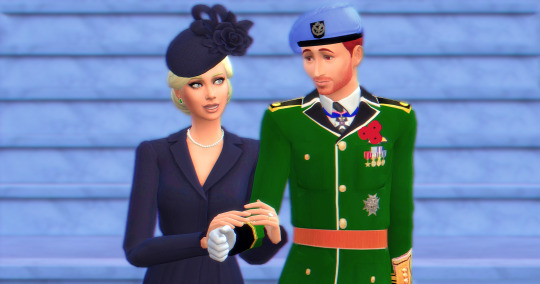

(Left: Major Sebastian Villa & Mrs Isabella Villa. Right: Their Highnesses the Grand Duke & Grand Duchess of Bordeaux)

(Front: HIH Princess Maria Aisha of Pierreland & HIH Prince Henri. Back: HRH Princess Magdalena of Lunaria & HIH Crown Prince Louis of Pierreland)

(TIM Emperor David & Empress Katalina of Pierreland)



In Edinburgh, it is customary for female members of the Royal Family to stand on the balacony on the nearby government building. The usual trio of HM Queen Marie Christine, HM the Queen Mother and HRH Duchess of Argyll were joined by special guest HIH Madame Hortense of Francesim. Meanwhile in Pierreland, almost the entire Imperial was present minus the very noticeable absence of the Grand Duke and Duchesses of Anjou but with the addition of HRH Princess Magadalena of Lunaria, daughter of beloved Pierrelander HRH Crown Princess Minerva of Lunaria. Lunaria and Francesim are both allies of Scots and Pierreland and both guests also had wreaths laid.
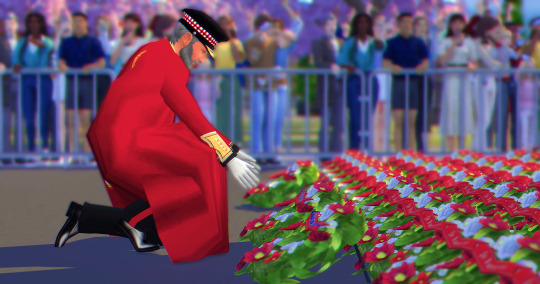
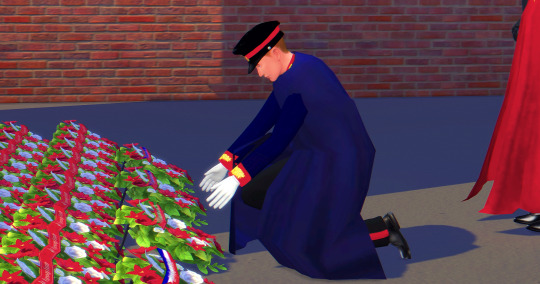
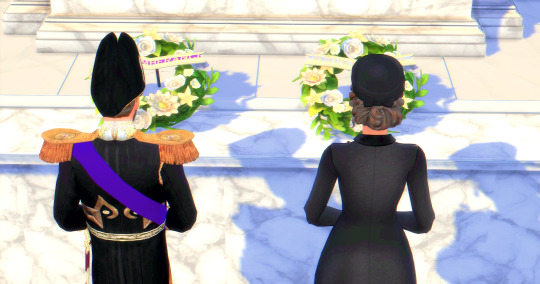

The Royal and Imperial Families laid wreaths at their respective monuments before their entire nations held 2 minutes of silence and reflection.


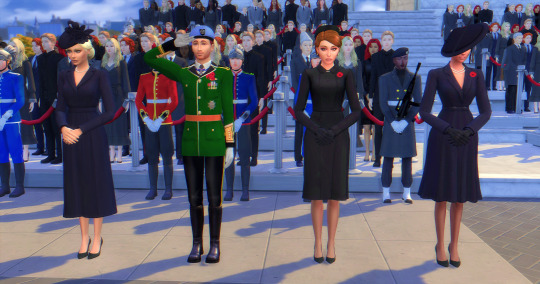
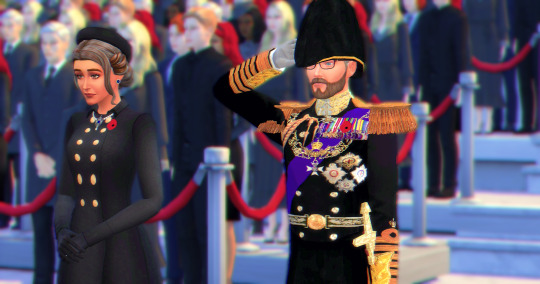

The wreaths will remain at the monuments for as long as possible. In Scots, the wreathes from left to right belong to: HIH Madame Hortense of Francesim, HRH Oliver, Duke of Rothsey, HM the King & HM the Queen.

In Pierreland wreaths are laid in the following order: on the ground from left to right: The Grand Duke & Grand Duchess of Bordeaux, HIH Prince Henri, HIH Crown Prince Louis, HRH Princess Magdalena of Lunaria, HIH Princess Maria Aisha, and Major & Mrs Villa. On top, lay the wreaths of TIM the Emperor and Empress.
@simsroyallegacy @empiredesimparte
#officalroyalsofpierreland#story#collab#sim: david#sim: katalina#sim: edmund#simsroyallegacy#sim: maria aisha#sim: henri#sim: louis#sim: oliver stuart#sim: hortense#empiredesimparte
29 notes
·
View notes
Note
Henry VI once disguised himself as a servant to meet Margaret of Anjou? This is his family tradition? Oh, it feels very cute ...
That is a story reported by Raffaelo de Negra to Bianca Maria Visconti, Duchess of Milan in a letter written in 1458:
When the queen landed in England the king dressed himself as a squire, the Duke of Suffolk doing the same, and took her a letter which he said the King of England had written.While the queen read the letter the king took stock of her, saying that a woman may be seen very well when she reads a letter, and the queen never found out it was the king because she was so engrossed in reading the letter, and she never looked at the king in his squire’s dress, who remained on his knees all the time. After the king had gone the Duke of Suffolk said: ‘Most serene queen, what do you think of the squire who brought the letter?’ The queen replied: 'I did not notice him, as I was occupied in reading the letter he brought.’ The duke remarked: 'Most serene queen, the person dressed as a squire was the most serene King of England,’ and the queen was vexed at not having known it, because she had kept him on his knees.
There is no other source for this story. Many would say this feels out-of-character for Henry VI, though we have no idea what he was really like to know whether this was "in character" or not. Some historians noted that the story is very much in the vein of a chivalric romance and it might not have actually happened. Katherine J. Lewis suggested that the story represents a Lancastrian response to Yorkist narratives depicting Margaret of Anjou as a disobedient wife and adulteress and given we know Margaret was big fan of chivalric romances, there might be something in that.
There is no evidence of this being a family tradition. There were no stories of disguises about the first meeting of Henry VI's parents, Henry V and Catherine de Valois, on 2 June 1419 during peace negotiations. Nor was Henry IV said to have disguised to have met either of his two wives. The only surviving narrative of his first marriage, to Mary de Bohun, was Froissart's account of John of Gaunt (Henry IV's father) masterminding her abduction, while Henry IV almost certainly had already met Joan of Navarre long before they married. There are no narratives of Gaunt disguising himself for any of his three marriages. Edward III is known to have disguised himself to participate in jousts but not to meet with his future wife.
15 notes
·
View notes
Photo

Vere novo , priori jam mutato consilio , Alienora virgo regia , insignis facie , sed prudentia & honestate prestantior , futura Regina Sicilie , atque cum ea Nymphe obsequiis apte regalibus , accepta benedictione parentum , ab urbe Neapoli gloriosas discessit , per Calabriam , propter maris tedium , usque Regium iter agens : quam discedentem Neapolitane matres , quantum spectantes oculi capere potuerunt , effusis pre gaudio lacrimis affequute sunt.
Gregorio Rosario, Bibliotheca scriptorum qui res in Sicilia gestas sub Aragonum imperio retulere, I, p.456-457
Eleonora was born in Naples in the summer of 1289 as the tenth child (third daughter) of Carlo II lo Zoppo of Anjou, King of Naples, Count of Anjou and Maine, Count of Provence and Forcalquier, Prince of Achaea, and of Maria of Hungary.
Nothing, in particular, is known about her childhood, which she must have spent with her numerous siblings in the many castles of the Kingdom.
She is first mentioned in a Papal bull dated 1300 in which Boniface VIII annulled the marriage of 10 years-old Eleonora to Philippe de Toucy, Prince of Antioch and Count of Tripoli, (the contract had been signed the year before) on account of the bride’s young age and the fact that family hadn’t asked for the Pope’s dispensation.
Two years later, there were discussions of a match with Sancho, the second son (and later successor) of Jaume II of Majorca, but the engagement never occurred.
Finally, in 1302, Eleonora’s fate was sealed. On August 31st 1302 the Houses of Anjou-Naples and of Barcelona signed the Peace of Caltabellotta, which ended the first part of the War of the Sicilian Vespers and settled (or tried to) the problem of which House should have ruled over Sicily. Following this treaty, the old Norman Kingdom’s territory (disputed between the French and Spanish born ruling houses) was to be divided into two parts, with Messina Strait as the ideal boundary line. The peninsular part, the Kingdom of Sicily, now designed as citra farum (on this side of the farum, meaning the strait, later simply known as the Kingdom of Naples ), and the island of Sicily, renamed the Kingdom of Trinacria, designed as ultra farum (beyond the farum).
The Peace of Caltabellotta stipulated that Angevin troops should evacuate the island, while the Aragonese ones should leave the peninsular part. Foundation of the peace would have been the marriage between princess Eleonora of Anjou and King Federico III (or II) of Sicily (“e la pau fo axi feyta , quel rey Carles lexava la illa de Sicilia al rey Fraderich, que li donava a Lieonor, qui era e es encara de les pus savies chrestianes, e la millor qui el mon fos, si no tant solament madona Blanca, sa germana, regina Darago. E lo rey de Sicilia desemparava li tot quant tenia en Calabria e en tot lo regne: e aço se ferma de cascuna de les parts, e que lentredit ques llevava de Sicilia; si que tot lo regne nach gran goig." in Ramon Muntaner, Crónica catalana, ch. CXCVIII). The pact dictated also that once Federico had died, the two kingdoms would be reunited under the Angevin rule. This clause won’t be fulfilled.
The bridal party had to wait until spring 1303 before setting off for her new country since sea storms had damaged part of the fleet and thus delayed the departure. The voyage had cost 610 ounces, where the Florentine bankers Bardi and Peruzzi were asked to advance the payment, and the groom pledged to repay them 140 ounces.
By May 1303, Eleonora and her companions arrived in Messina where she was warmly welcomed and where on Pentecost, May 26th, of the same year she got married to Federico in Messina’s Cathedral (“E a poch de temps lo rey Carles trames madona la infanta molt honrradament a Macina, hon fo lo senyor rey Fraderich, qui la reebe ab gran solemnitat. E aqui a Macina, a la sgleya de madona sancta Maria la Nova, ell la pres per muller e aquell dia fo llevat lentredit per lola la terra de Sicilia per un llegat del Papa, qui era archebisbe, que hi vench de part del Papa, e foren perdonats a tot hom tots los pe cats quen la guerra haguessen feyts: e aquell dia fo posada corona en lesta a madona la regina de Sicilia, e fo la festa la major a Macina que hanch si faes.” in Ramon Muntaner, Crónica catalana, ch. CXCVIII).
After the wedding, most of the bridal party returned to Naples, while the newlyweds proceeded to Palermo.
On July 14th 1305 Eleonora gave birth to the heir, who was called Pietro in honour of the child’s paternal grandfather, Pere III of Aragon. To celebrate his son’s birth, Federico III gifted his bride of Avola castle and the surrounding land, to which will be added the city of Siracusa (in 1314), Lentini, Mineo, Vizzini, Paternò, Castiglione, Francavilla and the farmhouses in Val di Stefano di Briga. This gift would mark the creation of the Camera reginale, which would become the traditional wedding present given to Sicilian Queen consorts, and eventually would be abolished in 1537.
Including Pietro, she would give birth to nine children: Costanza (1304 – post 1344), future Queen consort of Cyprus, Armenia and Princess consort of Antiochia; Ruggero (born circa in 1305 - ?) who would die young; Manfredi (1306-1317) first among his brothers to hold the title of Duke of Athens and Neopatras; Isabella (1310-1349) Duchess consort of Bavaria; Guglielmo (1312-1338) Prince of Taranto and heir to the Duchy of Athens and Neopatras following the death of his brother; Giovanni (1317-1348) Duke of Randazzo, Count of Malta, later also Duke of Athens and Neopatras and Regent of Sicily; Caterina (1320-1342) Abbess of St. Claire Nunnery in Messina; Margherita (1331-1377) Countess Palatine consort of the Rhine.
Through these donations Eleonora became a full-fledged vassal, and had to pay homage to her husband the King. Thanks to official documents, we get the idea that Eleonora tried to manage her lands as much personally as she could do, naming herself vicars, administrators, and granting tariff reductions. Federico indulged his wife as much as he could, although in some cases (like the management of the city of Siracusa) his will was the only one taken into account.
Despite almost every time she was unsuccessful, Eleonora fully embraced her role as mediator between the Aragonese and Angevins. For example, in 1312 her brother-in-law, King Jaume II of Aragon, asked her to dissuade her husband (Jaume’s brother) to ally himself with the Holy Roman Emperor Heinrich VII of Luxembourg since this alliance could generate new friction with the Angevin Kingdom, as well as with the Papacy (with the risk of stalling the Aragonese occupation of Sardinia). After the King of Aragon, it was Pope Clemente’s turn to ask Eleonora to convince Federico to make peace with Roberto of Anjou. In both cases, though, her conciliatory efforts didn’t work.
In 1321 she witnessed her son Pietro being associated to the throne and thus crowned in Palermo (“Anno domini millesimo tricentesimo vicesimo primo, dum Johannes Romanus Pontifex contra Fridericum Regem, & Siculos propter invasionem bonorum Ecclesiarum precipue fulminaret, Fridericus Rex primogenitum suum Petrum, convenientibus Siculis, coronavit in Regem, & patris obitum, inopinatum premetuens, & ut filius qui purus videbatur & simplex, ab adoloscentia regnare cum patre affuesceret patrisque regnando vestigiis inhereret […]” in Gregorio Rosario, Bibliotheca scriptorum ..., I, p. 482). Pietro’s coronation publicly violated the Treaty of Caltabellotta (as the Kingdom should have returned to the House of Anjou), causing the pursuing of warfare between Naples and Palermo. Once again Eleonora’s attempts at peace-making failed miserably, with her nephew, Carlo Duke of Calabria, refusing to even meet her in 1325, after he had successfully raided the outskirts of Messina.
The Queen didn’t have much luck in internal policy too as she failed to appease her husband and her protegé, Giovanni II Chiaramonte. After gravely wounding Count Francesco I Ventimiglia of Geraci (his brother-in-law and one of the King’s trustees), all that Eleonora could do was advise Chiaramonte to flee to avoid the death penalty.
Nevertheless, the Pope still hoped to use the Queen (who, at that time and alone in her Kingdom, was exempted from the Papal interdict) as mediator with her husband, promising to lift the excommunication in exchange for Federico’s backing down. Once again nothing happened.
On June 25th 1337 Federico III died near Paternò. He was buried in Catania since it was too hot for the body to be transported to Palermo (“Feretrum humeris nobiliores efferunt. Adsunt Regii filii, proceresque Regni. Exequias Regina, illustribus comitata matronis, prosequitur.” in Francesco Testa, De vita, et rebus gestis Federici 2. Siciliæ Regis, p.225). After the death of her husband, the now Dowager Queen turned to religion, following the example of those in her family who had consecrated themself to Christ (“At Heleonora certiorem fe de illa consolandi rationem inivit. Ipsa enim , ut Rex excessit e vita, ei, qui omnis consolationis fons est, fese in Virginum collegio Franciscanæ familiæ Catinæ devovit; in hoc Catharinan , & Margaritam filias imitata, quæ in ætatis flore, falsis terrestribus, contemptis bonis, Christ, cui fervire regnare est, in sacrarum Virginum Messanensi Collegio, de Basicò dicto, ejusdem Franciscanæ familiæ fese consecrarant; quod Collegium posteaquam Catharina fancte gubernavit, sanctitatis opinione commendata deceffit” in Francesco Testa, De vita..., p.226).
If Eleonora might have hoped to exert some kind of influence as many other Queen mothers did in the past and would do in the future over their weak-willed royal children, she would soon realize she had a powerful rival in the new Queen consort, her daughter-in-law, Elisabetta of Carinthia. Like Eleonora, the new Queen supported the Latin faction (a group of Sicilian noblemen who opposed the Aragonese rulership over Sicily, hoping the island would be returned under the influence of the Angevins instead). But, while Elisabetta had managed to raise the Palizzis to the highest positions at court, her mother-in-law still supported the Chiaramonte, making it possible for the exiled Giovanni II to return to Sicily, be pardoned by the King and see all his goods be returned. Soon though Chiaramonte resumed his personal feud against the Ventimiglia (also part of the Latin faction) and once again Eleonora's attempt to bring peace failed miserably. Only through Grand Justiciar Blasco II d'Alagona's intervetion, the crisis was averted.
In 1340, the Dowager Queen made a last attempt to appease the new Pope, Benedict XII. Unfortunately, the Sicilian envoys sent to Avignon to take an oath of vassalage (since Norman times Sicily theoretically belonged to the Papacy, who granted it to the Sovereigns who acted as Papal Legates) were treated roughly by the Pope, who declared Roberto of Anjou (Eleonora's brother) as Sicily's legitimate King.
Deeply distraught, the Dowager Queen resolved to definitely retire from public life. She spent what it remained on her life visiting the monastery of San Nicolo' d'Arena (Catania), joining the monks in their religious life. She died in one of the monastery's cells on August 10th 1341. Her body would be buried in the Church of San Francesco d'Assisi all'Immacolata (Catania), the construction of which she had personally promoted in 1329 to thank the Virgin Mary for protecting the city from one of many Mount Etna's eruptions.
Sources
AMARI MICHELE, La guerra del Vespro siciliano
CORRAO PIETRO, PIETRO II, re di Sicilia in Dizionario Biografico degli Italiani, Vol. 83
DE COURCELLES JEAN BAPTISTE PIERRE JULLIEN, Histoire généalogique et héraldique des pairs de France: des grands dignitaires de la couronne, des principales familles nobles du royaume et des maisons princières de l'Europe, Vol. XI,
FODALE SALVATORE, Federico III d’Aragona, re di Sicilia, in Dizionario Biografico degli Italiani, Vol. 45
GREGORIO ROSARIO, Bibliotheca scriptorum qui res in Sicilia gestas sub Aragonum imperio retulere, I,
KIESEWETTER ANDREAS, ELEONORA d'Angiò, regina di Sicilia, in Dizionario Biografico degli Italiani, Vol. 42
de MAS LATRIE LOUIS, Histoire de l'île de Chypre sous le règne des princes de la maison de Lusignan. 3
MUNTANER RAMON, Crónica catalana
Sicily/naples: counts & kings
TESTA FRANCESCO, De vita, et rebus gestis Federici 2. Siciliæ Regis
#historicwomendaily#historical women#history#history of women#herstory#eleanor of naples#frederick iii of sicily#house of aragon and sicily#people of sicily#women of sicily#aragonese-spanish sicily#myedit#historyedit
26 notes
·
View notes
Text
On This Day In History
September 17th, 1382: Maria of Anjou was crowned king of Hungary.
64 notes
·
View notes
Text









Mary of Anjou in The Crown Of The Kings season 3 icons
30 notes
·
View notes
Text
ROUND 4, MATCH 1
Admin's commentary: I mean if anyone can defeat Károly Róbert... Or if anyone can defeat I.István, could go either way. Though knowing this electorate, I know who I'd bet on (no I am not going to say it).
***

I.István (Štefan I.)
1000-1038
unifier of the Magyar tribes and first crowned king of Hungary (the damn crown is named after him for fuck's sake)
a literal saint - though not because he was particularly nice, mostly because of the fact that he was the first Magyar leader to be a proper Christian (unlike his dad Géza, who did get baptized, but still retained some of the pagan customs); plus he actively spread Christianity among Magyars (founding of the first Hungarian bishoprics, the one church for every 10 villages rule etc.), for better or for worse
created the basis for later Hungarian administration, including the minting of first Hungarian coins and the first law code in Hungarian history
helped Byzantines conquer Bulgaria
infamous for imprisoning and blinding his cousin and successor Vazul (chronicles blame his wife's influence, but they're probably just being sexist)
@biksarddedrak said about them: "The only thing, what you actually need to know is he was crowned on 25. of December year of our Lord 1000. The absolute unit of this man managed to haggle the pope to elevate whole Panonian basin on the most easly memorabe day. (...) I. Istvám defended his right to rule from several pagan lords who wished to deposed him in the beginig of his rule. And he did it from glorious city of Nitra."

I.Károly (Karol I.) - but be honest, we all know him as Károly/Karol Róbert
1301-1342
spent the first few years on the throne fending off antikings, namely Václav III., who then gave up and passed his claim onto Otto of Bavaria, whom Károly subsequently defeated
upon his ascencion to the throne country basically ruled by the feuding nobles, also know in this period as oligarchs, he managed to consolidate his reign and regain most of the royal power trough a combination of warfare (Rozgony/Rozhanovce 1312 HELLOOO) and appeasing them with court functions
I don't even know where to START with this guy's reforms - seriously, he minted the first gold coins in Hungary, instated the banderial system (levy of the royal army from the soldiers drafted by the cities, comitates and nobles, look it was a big deal, just trust me), reformed the administation of the country and so, so much more I can't get into; basically, this man was Maria Theresa before Maria Theresa
he mostly avoided wars because of the bad shape of Hungarian treasury, though he did lead a couple of them (conflicts with Venice and Wallachia)
initiator of the 1335 meeting in Visegrád with John of Luxembourg and Casimir III. of Poland; basically, we have him to thank for the name Visegrád Four
(admin is from Košice, so he has just inherently won in her eyes because of Rozhanovce)
@tunderilona said about him: #károly róbert sweep he literally reformed the entire country
@cdqueer said about him: #hes got that anjou rizz (perfected by i. lajos <3)
@tonhalszendvics said about him: #of course károly robi had to fight off everyone in his first years#he was crowned officially in 1308#he fucked up two times before that#i mean you need to be crowned in székesfehérvár by the archbishop of esztergom with the holy crown#third time the charm he did it
7 notes
·
View notes
Text

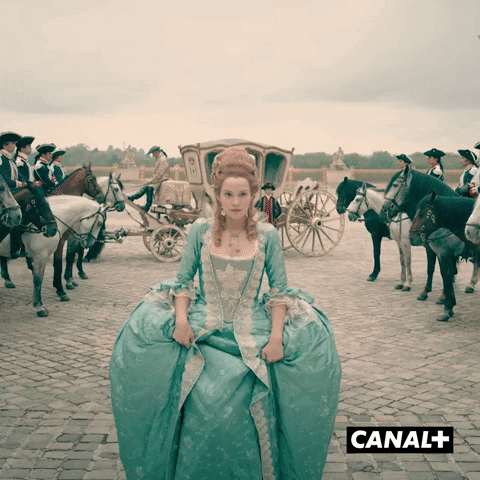
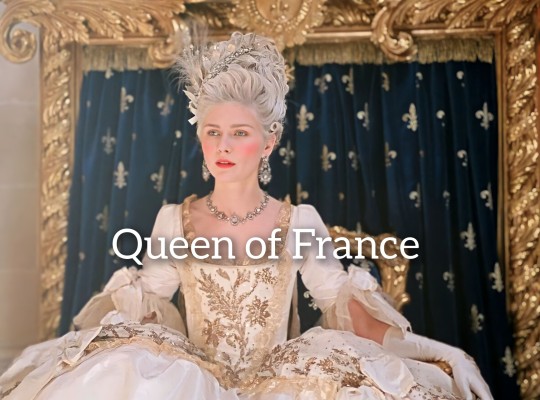




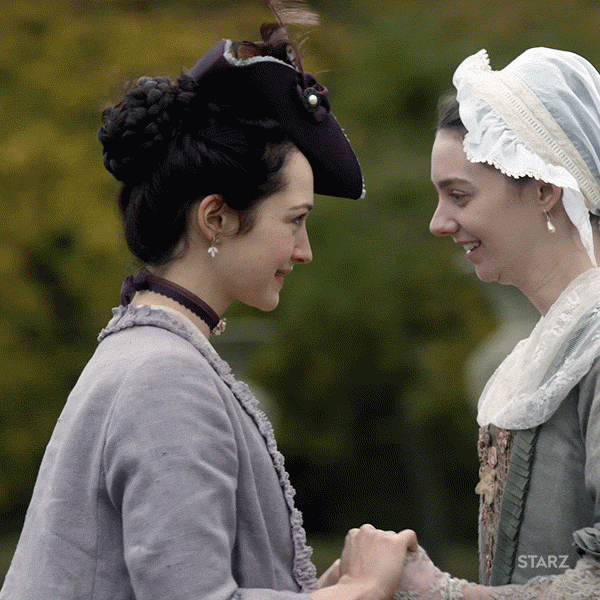


AU House of Bourbons: Children Louis XVI and Marie Antoinette.
Maria Theresa(1778 - 1851). Queen of England. Wife of William IV and mother of 6 children: George V, Charlotte, Louis, Mary, Albert and Antoinette. Despite the great age difference the spouses were close to each other. Maria Theresa had a strong influence on her husband. She was also beloved by the British people for her charity, modesty and kindness. The queen spent most of her time in charity.
Louis XVII(1781 - 1848). King of France. Husband of Marie Theresa of Portugal. Despite the fact that this marriage was a marriage of convenience the spouses loved each other and had many children. The reign of Louis is characterized by the blossoming of French culture, military power and political weight. The marriage produced 15 children: Charles X, Joaquina, Antoinette, Philip, Victoria, Louise, Elizabeth, Francis, Alexandr, Nicolas, Henry, Therese, Gedeon, Leon and Andrew.
Louis Charles(1785 - 1840). Duke of Anjou. Husband of Amelia of Great Britain. From the first days of their marriage the spouses felt a chill for each other. But after a few months between them arose affection, in addition, Amelia very much liked the parents of her husband. The Dauphin was well educated, loved music, preferred serious conversations to hunting and balls. Father of 7 children: Louis, Amelia, Geoffroy, Paul, Gaston, Charlotte and Charles.
Sophia Beatrice(1786 - 1846). Queen of Spain. Wife of Ferdinand VII. The marriage was very successful, the spouses loved each other. Sofia did not shine in politics, but was loved by the people. They had 8 children: Maria, Ferdinand VIII, Carlos, Antoinette, Luisa, Marcelio, Luis and Teresa.
AU Дом Бурбонов: Дети Людовика XVI и Марии Антуанетты.
Мария Тереза(1778 - 1851). Королева Англии. Жена Вильгельма IV и мать 6 детей: Георг V, Шарлотта, Луи, Мария, Альберт и Антуанетта. Несмотря на большую разницу в возрасте супруги были близки друг к другу. Мария Тереза имела сильное влияние на мужа. Также она была любима британским народом за милосердие, скромность и доброту. Большую часть своего времени королева уделяла благотворительности.
Людовик XVII(1781 - 1848). Король Франции. Муж Марии Терезы Португальской. Несмотря на то, что этот брак был по расчёту супруги любили друг друга и имели много детей. Правление Людовика характеризуется расцветом французской культуры, военной мощи и политического веса. В браке родилось 15 детей: Карл X, Жоакина, Антуанетта, Филипп, Виктория, Луиза, Елизавета, Франсуа, Александр, Николя, Генрих, Тереза, Гедеон, Леон и Андре.
Луи Шарль(1785 - 1840).Герцог Анжуйский. Муж Амелии Великобританской. С первых дней брака супруги чувствовали прохладу друг к другу. Но через несколько месяцев между ними возникла привязанность, к тому же Амелия очень нравилась родителям своего мужа. Дофин был хорошо образован, любил музыку, предпочитал серьёзные разговоры охоте и балам. Отец 7 детей: Луи, Амелия, Жоффруа, Поль, Гастон, Шарлотта и Шарль
София Беатриса(1786 - 1846). Королева Испании. Жена Фердинанда VII. Брак был очень успешным, супруги любили друг друга. София не блистала в политике, но была любима народом. У них родилось 8 детей: Мария, Фердинанд VIII, Карлос, Антуанетта, Луиза, Марселио, Луис и Тереза.
#history#history au#royal family#royalty#au#marie antoinette#louis xvi#history of france#french royal family#french queen#french kings#french royalty#french#french royal#french royals#france#frenchqueens#royals#roy#royal#royalts#17th century#18th century#louis xvi off rance#french monarchy#british history#spenish history#portuguese history#the rose of versailles#versailles
8 notes
·
View notes